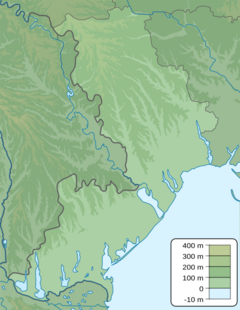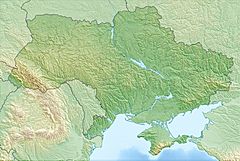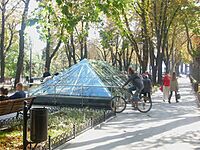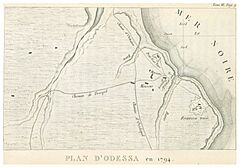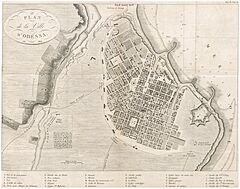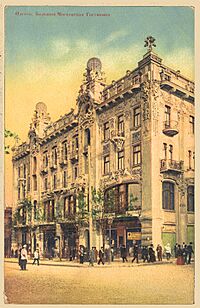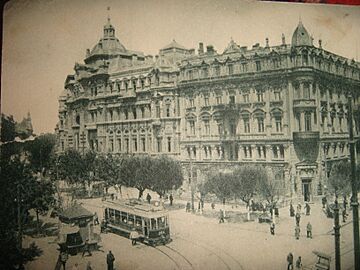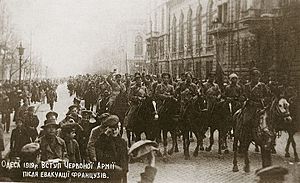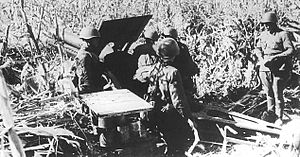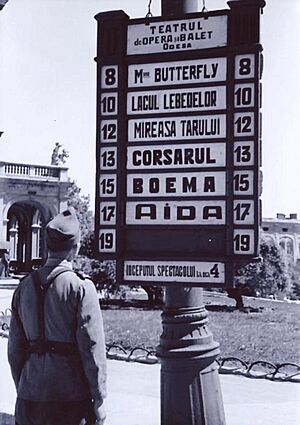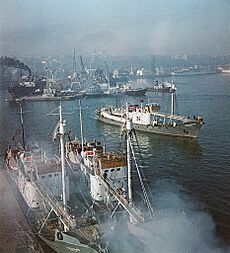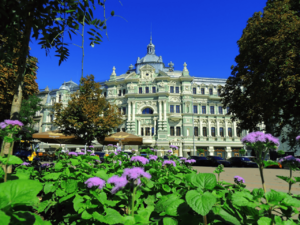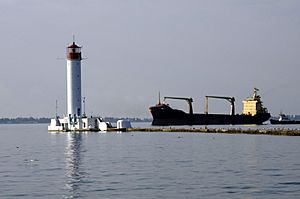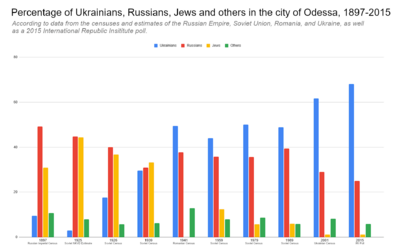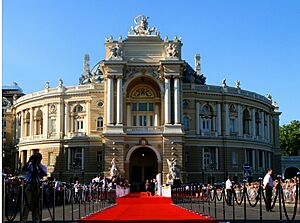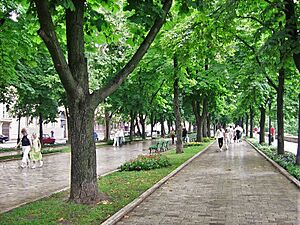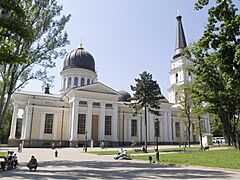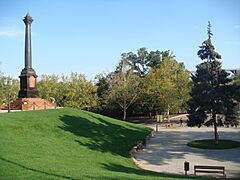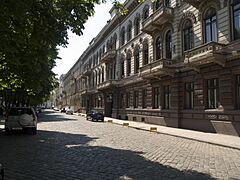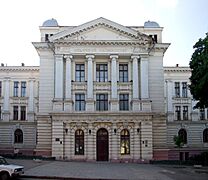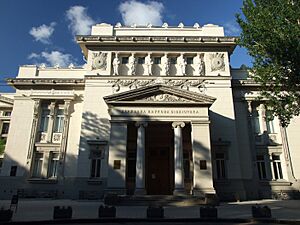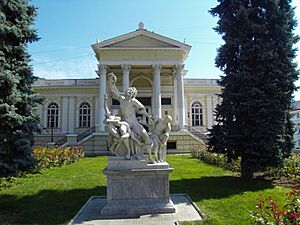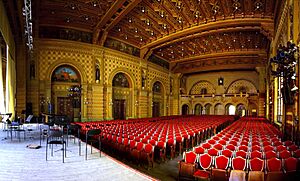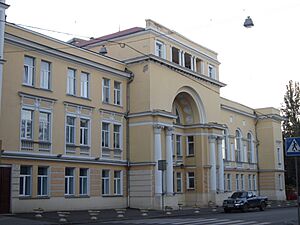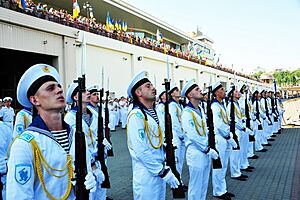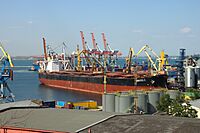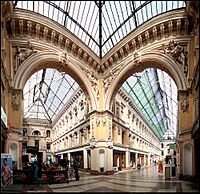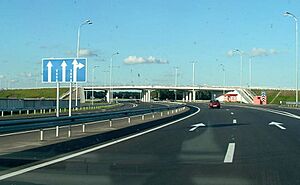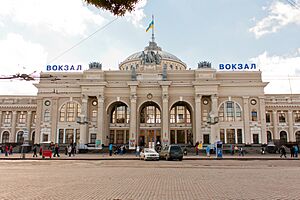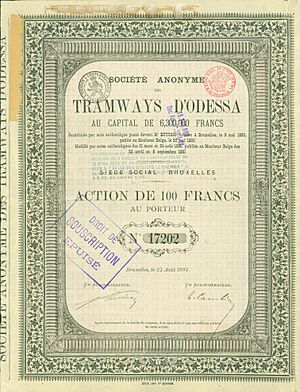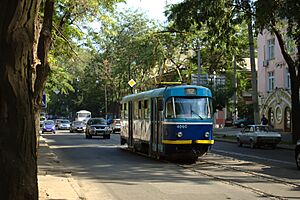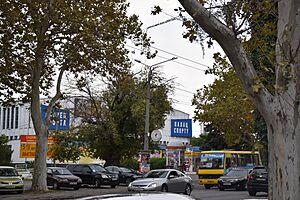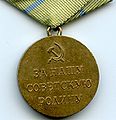Odesa facts for kids
Quick facts for kids
Odesa
Одеса
Odessa
|
|||||
|---|---|---|---|---|---|
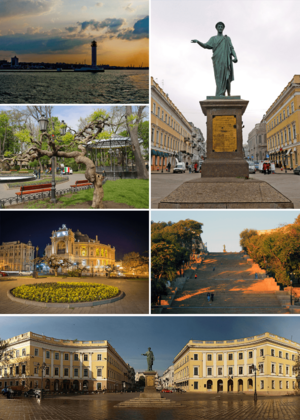
Clockwise from top left: Vorontsov Lighthouse; Monument to the Duc de Richelieu; Potemkin Stairs; Square de Richelieu; Opera and Ballet Theatre; and city garden
|
|||||
|
|||||
| Country | |||||
| Oblast | Odesa Oblast | ||||
| Raion | Odesa Raion | ||||
| Hromada | Odesa urban hromada | ||||
| First mentioned | 19 May 1415 | ||||
| Area | |||||
| • City | 162.42 km2 (62.71 sq mi) | ||||
| • Metro | 3,656 km2 (1,412 sq mi) | ||||
| Elevation | 40 m (130 ft) | ||||
| Highest elevation | 65 m (213 ft) | ||||
| Lowest elevation | −4.2 m (−14 ft) | ||||
| Population
(2022)
|
|||||
| • City | 1,010,537 | ||||
| • Rank | 3rd in Ukraine | ||||
| • Density | 6,221.75/km2 (16,114.3/sq mi) | ||||
| • Metro | 1,378,490 | ||||
| Demonym(s) | English: Odesan, Odesite, Odessan, Odessite Ukrainian: одесит, одеситка Russian: одессит, одесситка |
||||
| Time zone | UTC+2 (EET) | ||||
| • Summer (DST) | UTC+3 (EEST) | ||||
| Postal codes |
65000–65480
|
||||
| Area code(s) | +380 48 | ||||
| Website | www.omr.gov.ua/en/ | ||||
| Official name: The Historic Centre of Odesa | |||||
| Type: | Cultural | ||||
| Criteria: | ii, iv | ||||
| Designated: | 2023 (18th extraordinary World Heritage Committee session) | ||||
| Reference #: | 1703 | ||||
| UNESCO region: | Europe | ||||
| Endangered: | 2023– | ||||
Odesa (also spelled Odessa) is a major city and port in Ukraine. It is the third largest city in the country. Odesa is located in the southwest of Ukraine, right on the northwestern coast of the Black Sea. It is an important center for transport and culture. As of January 2021, about 1,010,537 people lived in Odesa.
In ancient times, a large Greek settlement was here around 6th century BC. The first time a Slavic port called Kotsiubijiv was mentioned was in 1415. It was part of the Grand Duchy of Lithuania. Later, the Ottoman Empire took control in 1529, calling it Hacibey. In 1794, Catherine the Great, the Russian empress, ordered a navy harbor and trading place to be built here. It was soon named Odesa. From 1819 to 1858, Odesa was a special "free port" where trade was easier. During the 19th century, Odesa became the fourth largest city in the Russian Empire. Its buildings look more like those from the Mediterranean region than typical Russian styles. They were influenced by French and Italian designs.
Odesa has a warm-water port, meaning it doesn't freeze in winter. This is very important for trade. The city has two main ports: the Port of Odesa and Pivdennyi Port. These ports are big transport hubs connected to railways. They also have oil and chemical facilities linked to pipelines that go to Russia and other European countries. In 2000, a part of Odesa's port became a free economic zone for 25 years. This means businesses there get special benefits.
Contents
- Understanding the Name Odesa
- Exploring Odesa's Past
- Odesa's Location and Environment
- Who Lives in Odesa?
- Odesa's Cityscape and Architecture
- Learning and Education in Odesa
- Odesa's Rich Culture
- Odesa's Economy and Business
- Scientists from Odesa
- Getting Around Odesa
- Sports in Odesa
- Odesa's Sister Cities
- Images for kids
- See also
Understanding the Name Odesa
- [Odesa or Odessa] Error: {{Lang-xx}}: text has italic markup (help) /oʊˈdɛsə/
- Ukrainian: Одеса [oˈdɛsɐ]
- Russian: Одесса [ɐˈdʲes(ː)ə]
Odesa is sometimes called the "Pearl by the Sea" or the "Southern Capital." It's also known as "Odesa-mama" and the "Humour Capital."
In 1795, the city was named Odesa. This name was chosen to honor an ancient Greek city called Odessos. This ancient city was thought to be located nearby. The traditional English spelling was "Odessa," which came from the Russian name. However, after Ukraine became independent in 1991, the spelling "Odesa" became the official international way to write the name. This matches the Ukrainian language.
Exploring Odesa's Past
![]() Grand Duchy of Lithuania 1415–84
Grand Duchy of Lithuania 1415–84
![]() Ottoman Empire 1484–1789
Ottoman Empire 1484–1789
![]() Russian Empire 1789–1917
Russian Empire 1789–1917
Beginning of 1917–21 Revolution
![]() Russian Provisional Government 1917
Russian Provisional Government 1917
![]() UPR Dec. 1917–Nov. 1918
UPR Dec. 1917–Nov. 1918
![]() OSR Jan.–March 1918
OSR Jan.–March 1918
![]() Ukrainian State March–Dec. 1918
Ukrainian State March–Dec. 1918
![]() AFSR Dec. 1918–April 1919
AFSR Dec. 1918–April 1919
![]() PWPGU/
PWPGU/![]() UkSSR April–Aug. 1919
UkSSR April–Aug. 1919
![]() AFSR Aug. 1919–Feb. 1920
AFSR Aug. 1919–Feb. 1920
![]() /
/![]() /
/![]() UkSSR Feb. 1920–Dec. 1922
UkSSR Feb. 1920–Dec. 1922
End of the 1917–21 Revolution
![]() USSR 1922–41
USSR 1922–41
![]() Kingdom of Romania 1941–44
Kingdom of Romania 1941–44
![]() USSR 1944–91
USSR 1944–91
![]() Ukraine 1991–present
Ukraine 1991–present
Early Settlements and Ancient Times
Odesa was home to a large Greek settlement as early as the 6th century BC. Archeologists have found many artifacts that show strong connections between the Odesa area and the eastern Mediterranean.
During the Middle Ages, different groups ruled the Odesa region. These included nomadic tribes, the Golden Horde, the Crimean Khanate, the Grand Duchy of Lithuania, and the Ottoman Empire. A fortress called Khadjibey was located here. It was first mentioned in 1415 when a ship sailed from there to Constantinople.
Odesa's Founding and Growth
In 1789, Russian forces took control of Khadjibey during a war with the Ottoman Empire. A Spanish officer named José de Ribas helped in this victory. Today, the main street in Odesa, Deribasivska Street, is named after him.
In 1794, Empress Catherine the Great ordered a new navy harbor and trading port to be built at Khadjibey. The city was carefully planned by engineers. In 1795, Khadjibey was officially renamed Odesa.
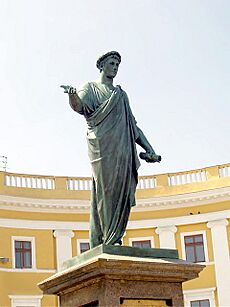
The city grew quickly, thanks to leaders like the Duc de Richelieu. He was the city's governor from 1803 to 1814. He helped design the city and set up its services. A bronze statue of him was put up in 1828.
In 1819, Odesa became a free port, which helped its trade grow even more. This status lasted until 1859. Odesa attracted people from many different backgrounds. This included Albanians, Armenians, Greeks, Italians, Jews, Poles, Russians, and Ukrainians. This mix of cultures made Odesa a very unique and diverse city.
Odesa in the 19th and Early 20th Centuries
Odesa's growth was briefly stopped by the Crimean War (1853–1856). But it soon recovered and became Russia's largest port for exporting grain. In 1866, the city was connected by railway to other major cities like Kyiv.
The city had a large Jewish community in the 19th century. However, this community faced difficult times, including events where people attacked Jewish neighborhoods. Many Jewish people left Odesa after 1882, with some moving to Palestine.
Odesa also had a large Italian community. They greatly influenced the city's culture, art, and architecture. The famous Potemkin Stairs and the Odesa Opera and Ballet Theater were built with their help. For a time, Italian was the second official language in Odesa.
Revolution and Soviet Era
In 1905, there was a workers' uprising in Odesa. The crew of the Russian battleship Potemkin supported it. The famous film Battleship Potemkin shows a scene on the Potemkin Stairs. This scene, though not entirely accurate to history, made the stairs very famous.
After the October Revolution in 1917, Odesa saw many changes. Different groups fought for control of the city during the Russian Civil War. Eventually, the Soviet Red Army took control by 1920. The people of Odesa suffered from a severe famine in 1921–1922.
Odesa in World War II
During World War II, Odesa was attacked by Romanian and German troops in August 1941. The city's defense lasted for 73 days. A famous female sniper, Lyudmila Pavlichenko, fought in the battle for Odesa.
The city fell to the Axis powers on October 16, 1941. It was then controlled by Romania. Many people in Odesa, especially Jewish residents, suffered greatly during this time. The city was finally freed by the Red Army on April 10, 1944. Odesa was one of the first four Soviet cities to be given the title of "Hero City" in 1945.
Odesa After World War II
After the war, Odesa continued to grow. Many Jewish people from Odesa moved to Israel and other countries between the 1970s and 1990s. Despite this, the city's population grew with new people moving in from other parts of the Soviet Union.
Odesa kept its unique mix of cultures. The way people spoke Russian in Odesa, with a special accent, became famous. This "Odesa dialect" was often used in jokes and comedy shows.
Odesa in Independent Ukraine
In 1991, Odesa Oblast voted for Ukraine's independence. Odesa remains a city of over 1 million people. Its main industries include shipbuilding, oil refining, and food processing. It is also an important naval base. The city is known for its huge outdoor market, the Seventh-Kilometer Market. This is one of the largest markets in Europe.
In 2014, Odesa saw some clashes between different groups. On May 2, 2014, some protests led to violence and a building fire, resulting in deaths.
In 2022, during the 2022 Russian invasion of Ukraine, Odesa faced missile attacks. On April 23, 2022, Russian troops bombed military and residential buildings, causing deaths and injuries.
On January 25, 2023, UNESCO declared Odesa's historic city center a World Heritage Site. It was also added to the List of World Heritage in Danger to help protect it during the ongoing conflict.
Odesa's Location and Environment
Where is Odesa Located?
Odesa is located in southern Ukraine, on the northwestern coast of the Black Sea. It's about 31 kilometers (19 miles) north of the Dniester River's mouth. The city sits on hills that overlook a small harbor. The average height of the city is about 40 meters (131 feet) above sea level.
The city covers an area of about 162.42 square kilometers (62.71 square miles). The Dniester River provides the city with its drinking water. The area around Odesa is mostly flat, with no large mountains. Odesa is famous for its tree-lined streets.
Odesa's location on the Black Sea coast has helped it become a popular tourist spot. Arkadia Beach is a large sandy beach south of the city center. Odesa's sandy beaches are special in Ukraine, as many other coastal areas have rocky beaches.
The cliffs along the coast near the city sometimes have landslides. City planners work to keep buildings safe from these changes. Also, there are many tunnels and caves underground, which can sometimes cause buildings to collapse.
Odesa's Climate and Weather
Odesa has a climate with hot summers and relatively mild, dry winters. This climate is great for summer tourism. In the past, wealthy people visited Odesa for its healthy climate. This led to the growth of spas and luxury hotels.
The average sea temperature is 13–14°C (55–57°F) annually. From June to September, the sea temperature in Odesa's bay is usually above 20°C (68°F).
Winters are cold but milder than in most of Ukraine. Temperatures rarely drop below -10°C (14°F). Summers are warm with more rain, and temperatures often reach the high 20s and low 30s °C (80s–90s °F). Snowfall is usually light. The harbor rarely freezes.
| Climate data for Odesa (1991–2020, extremes 1894–present) | |||||||||||||
|---|---|---|---|---|---|---|---|---|---|---|---|---|---|
| Month | Jan | Feb | Mar | Apr | May | Jun | Jul | Aug | Sep | Oct | Nov | Dec | Year |
| Record high °C (°F) | 15.7 (60.3) |
19.2 (66.6) |
24.8 (76.6) |
29.4 (84.9) |
33.3 (91.9) |
37.2 (99.0) |
39.3 (102.7) |
38.0 (100.4) |
35.4 (95.7) |
31.1 (88.0) |
26.0 (78.8) |
16.9 (62.4) |
39.3 (102.7) |
| Mean daily maximum °C (°F) | 2.3 (36.1) |
3.4 (38.1) |
7.7 (45.9) |
13.6 (56.5) |
20.3 (68.5) |
25.1 (77.2) |
27.9 (82.2) |
27.7 (81.9) |
21.8 (71.2) |
15.3 (59.5) |
9.1 (48.4) |
4.2 (39.6) |
14.9 (58.8) |
| Daily mean °C (°F) | −0.4 (31.3) |
0.4 (32.7) |
4.3 (39.7) |
10.0 (50.0) |
16.2 (61.2) |
20.8 (69.4) |
23.4 (74.1) |
23.1 (73.6) |
17.8 (64.0) |
12.0 (53.6) |
6.3 (43.3) |
1.5 (34.7) |
11.3 (52.3) |
| Mean daily minimum °C (°F) | −2.7 (27.1) |
−2.1 (28.2) |
1.6 (34.9) |
6.9 (44.4) |
12.6 (54.7) |
16.9 (62.4) |
19.1 (66.4) |
18.5 (65.3) |
14.0 (57.2) |
8.9 (48.0) |
3.9 (39.0) |
−0.8 (30.6) |
8.1 (46.6) |
| Record low °C (°F) | −26.2 (−15.2) |
−28.0 (−18.4) |
−16.0 (3.2) |
−5.9 (21.4) |
0.3 (32.5) |
5.2 (41.4) |
7.5 (45.5) |
7.9 (46.2) |
−0.8 (30.6) |
−13.3 (8.1) |
−14.6 (5.7) |
−19.6 (−3.3) |
−28.0 (−18.4) |
| Average precipitation mm (inches) | 43 (1.7) |
35 (1.4) |
35 (1.4) |
28 (1.1) |
39 (1.5) |
47 (1.9) |
45 (1.8) |
40 (1.6) |
44 (1.7) |
37 (1.5) |
39 (1.5) |
38 (1.5) |
470 (18.5) |
| Average extreme snow depth cm (inches) | 2 (0.8) |
2 (0.8) |
1 (0.4) |
0 (0) |
0 (0) |
0 (0) |
0 (0) |
0 (0) |
0 (0) |
0.2 (0.1) |
4 (1.6) |
9 (3.5) |
41 (16) |
| Average rainy days | 9 | 7 | 10 | 11 | 12 | 13 | 10 | 8 | 9 | 10 | 13 | 10 | 122 |
| Average snowy days | 11 | 10 | 6 | 0.4 | 0 | 0 | 0 | 0 | 0 | 0.2 | 4 | 9 | 41 |
| Average relative humidity (%) | 82.5 | 80.7 | 78.4 | 74.5 | 71.0 | 70.6 | 66.0 | 65.4 | 71.8 | 77.1 | 81.9 | 83.6 | 75.3 |
| Mean monthly sunshine hours | 55 | 88 | 153 | 219 | 299 | 315 | 348 | 323 | 239 | 158 | 63 | 48 | 2,308 |
| Source 1: Pogoda.ru | |||||||||||||
| Source 2: NOAA (humidity 1981–2010, sun 1991–2020) | |||||||||||||
Who Lives in Odesa?
| Historical population | ||
|---|---|---|
| Year | Pop. | ±% p.a. |
| 1795 | 2,349 | — |
| 1800 | 6,000 | +20.63% |
| 1802 | 9,000 | +22.47% |
| 1813 | 35,000 | +13.14% |
| 1829 | 52,000 | +2.51% |
| 1832 | 60,000 | +4.89% |
| 1844 | 77,800 | +2.19% |
| 1858 | 104,200 | +2.11% |
| 1863 | 118,900 | +2.67% |
| 1873 | 193,513 | +4.99% |
| 1880 | 217,000 | +1.65% |
| 1885 | 240,600 | +2.09% |
| 1891 | 297,600 | +3.61% |
| 1897 | 403,815 | +5.22% |
| 1907 | 449,700 | +1.08% |
| 1910 | 506,000 | +4.01% |
| 1912 | 635,000 | +12.02% |
| 1914 | 481,500 | −12.92% |
| 1920 | 454,200 | −0.97% |
| 1925 | 325,354 | −6.45% |
| 1936 | 534,000 | +4.61% |
| 1939 | 601,651 | +4.06% |
| 1956 | 607,000 | +0.05% |
| 1959 | 667,182 | +3.20% |
| 1970 | 891,546 | +2.67% |
| 1979 | 1,046,133 | +1.79% |
| 1989 | 1,115,371 | +0.64% |
| 2001 | 1,029,049 | −0.67% |
| 2011 | 1,009,145 | −0.20% |
| 2022 | 1,010,537 | +0.01% |
| at | ||
Diverse Backgrounds of Odesa's Residents
- 1897
- Russians: 198,233 people (49.09%)
- Jews: 124,511 people (30.83%)
- Ukrainians: 37,925 people (9.39%)
- Poles: 17,395 people (4.31%)
- Germans: 10,248 people (2.54%)
- Greeks: 5,086 people (1.26%)
- Tatars: 1,437 people (0.36%)
- Armenians: 1,401 people (0.35%)
- Belarusians: 1,267 people (0.31%)
- French: 1,137 people (0.28%)
- 1926
- Russians: 162,789 people (39.97%)
- Jews: 153,243 people (36.69%)
- Ukrainians: 73,453 people (17.59%)
- Poles: 10,021 people (2.40%)
- Germans: 5,522 people (1.32%)
- Belarusians: 2,501 people (0.60%)
- Armenians: 1,843 people (0.44%)
- Greeks: 1,377 people (0.33%)
- Bulgarians: 1,186 people (0.28%)
- Moldovans: 1,048 people (0.25%)
- 1939
- Jews: 200,961 people (33.26%)
- Russians: 186,610 people (30.88%)
- Ukrainians: 178,878 people (29.60%)
- Poles: 8,829 people (1.46%)
- Germans: 8,424 people (1.39%)
- Bulgarians: 4,967 people (0.82%)
- Moldovans: 2,573 people (0.43%)
- Armenians: 2,298 people (0.38%)
- 1941
- Ukrainians: 120,945 people (49.45%)
- Russians: 92,584 people (37.85%)
- Germans: 8,643 people (3.53%)
- Poles: 7,488 people (3.06%)
- Bulgarians: 4,928 people (2.01%)
- Moldovans: 3,224 people (1.32%)
- Tatars: 436 people (0.18%)
- Lipovans: 429 people (0.17%)
- 2001
- Ukrainians: 622,900 people (61.6%)
- Russians: 292,000 people (29.0%)
- Bulgarians: 13,300 people (1.3%)
- Jews: 12,400 people (1.2%)
- Moldovans: 7,600 people (0.7%)
- Belarusians: 6,400 people (0.6%)
- Armenians: 4,400 people (0.4%)
- Poles: 2,100 people (0.2%)
Odesa is home to many different nationalities and ethnic groups. These include Albanians, Armenians, Bulgarians, Greeks, Jews, Poles, Romanians, and Turks. Until the early 1940s, the city had a large Jewish population. After World War II, many Jewish people moved away.
For most of the 19th century, Russians were the largest ethnic group in Odesa, followed by Jews. According to the 2001 Ukrainian census, Ukrainians make up the largest group today (61.6%). Russians are the second largest (29%).
Languages Spoken in Odesa
Distribution of the population of the city of Odesa by native language according to the 2001 census:
| Language | Number | Percentage |
|---|---|---|
| Ukrainian | 307 196 | 30.41% |
| Russian | 654 128 | 64.75% |
| Other or undecided | 48 974 | 4.84% |
| Total | 1 010 298 | 100.00% |
In 2021, a survey showed that 96% of Odesa's residents spoke some Russian at home. 29% spoke some Ukrainian at home. Many people speak both languages. The use of Ukrainian is growing in popularity. A 2023 survey showed that 42% of people in Odesa Oblast now speak Ukrainian at home.
Odesa's Cityscape and Architecture
Many of Odesa's buildings have a unique Mediterranean style. This is different from other Ukrainian cities. Architects like Francesco Boffo designed many important buildings in the early 19th century. These include a palace for the Governor and the Potocki Palace.
One of the city's most famous buildings is the Opera and Ballet Theatre. It was finished in 1887 and is known as one of the world's finest opera houses. Its luxurious hall is built in the rococo style. People say that even a whisper on stage can be heard anywhere in the hall.
Odesa's most famous symbol is the Potemkin Stairs. This huge staircase creates an optical illusion. From the top, you only see large steps. From the bottom, all the steps seem to blend into one big shape. The original 200 steps were designed by Francesco Boffo and built between 1837 and 1841. The stairs became famous because of the film Battleship Potemkin.
Most of Odesa's old houses were built from limestone mined nearby. The abandoned mines were later used by smugglers. This created a giant network of tunnels under Odesa, known as the Odesa catacombs. During World War II, these catacombs were used as hiding places for fighters and civilians.
Derybasivska Street is a beautiful pedestrian street. It's named after José de Ribas, one of Odesa's founders. In summer, people enjoy sitting at outdoor cafes or walking along the cobblestone street. Prymorsky Bulvar is another grand street with many impressive buildings.
Odesa's port is one of the busiest on the Black Sea. It handles cargo, oil, and passengers all year round. The port is protected by breakwaters, so weather doesn't stop its work.
Odesa has many different religious buildings. These include the Orthodox Transfiguration Cathedral, the Catholic Assumption of the Blessed Virgin Mary Cathedral, and the Brodsky Synagogue. There are also historic cemeteries.
In late 2022, a monument to the founders of Odesa, which included a statue of Catherine the Great, was moved to the Odesa Fine Arts Museum.
Parks and Gardens to Explore
Odesa has many public parks and gardens. These include Preobrazhensky, Gorky, and Victory parks. The city also has a university botanical garden.
The City Garden is one of the most famous. It was created in 1803 by Felix De Ribas. He later gave it to the people of Odesa. The garden has a bandstand for outdoor theater and a musical fountain.
Odesa's largest park is Shevchenko Park. It was founded in 1875 by Emperor Alexander II. The park is near the city center and the sea. It has cultural and entertainment areas, wide paths, and monuments. The local football team's stadium, Chornomorets Stadium, is also in the park.
Learning and Education in Odesa
Odesa is home to several universities and colleges. The most famous is the Odesa 'I.I. Mechnykov' National University. It was founded in 1865 and is one of Ukraine's top research universities.
Other important universities include:
- Odesa National Economics University (founded 1921)
- Odesa National Medical University (founded 1900)
- Odesa National Polytechnic University (founded 1918)
- National University Odesa Law Academy
- National University «Odesa Maritime Academy» (trains sailors for merchant ships)
- South Ukrainian National Pedagogical University (trains teachers)
Besides state universities, Odesa also has many private schools and academies. For younger students, there are many state-run primary and secondary schools.
Odesa's Rich Culture
Museums, Art, and Music
The Fine Arts Museum is the largest art gallery in the city. It has paintings from the 17th to 21st centuries. The Odesa Museum of Western and Eastern Art displays European and Eastern art, including works by famous painters.
The Alexander Pushkin Museum tells about the time the famous Russian poet Alexander Pushkin lived in Odesa. Other museums include the Odesa Archeological Museum and the Odesa Numismatics Museum.
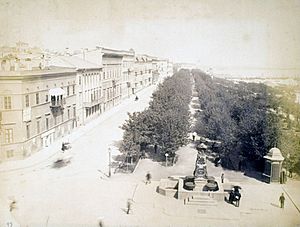
Odesa has produced many famous musicians, especially violinists and pianists. These include Nathan Milstein, David Oistrakh, and Sviatoslav Richter. The Odesa International Film Festival is held here every year since 2010.
Famous Writers from Odesa
Odesa is known for its many writers. These include Isaak Babel, who wrote stories about the city. The authors Ilf and Petrov, who wrote The Twelve Chairs, were also from Odesa. Other writers include Yury Olesha and Valentin Kataev.
These writers and comedians helped create the "Odesa myth." This idea describes Odesans as clever, street-smart, and always positive. The "Odesa dialect" of Russian, influenced by the city's Jewish community, is a big part of this image.
Celebrations and Fun Events
April Fools' Day, on April 1, is a very popular festival in Odesa. People dress in colorful clothes and play jokes. This tradition started in the 1970s and is now a big festival.
Notable People from Odesa
Many famous people were born or lived in Odesa:
- Pyotr Schmidt (1867–1906), a leader in the Sevastopol uprising.
- Ze'ev Jabotinsky (1880–1940), a key figure in Zionism.
- Rodion Malinovsky (1898–1967), a Soviet military commander in World War II.
- Simon Wiesenthal (1908–2005), a famous Nazi hunter.
- Hayim Nahman Bialik (1873–1934), a national Hebrew poet.
- Yitzhak Frenkel Frenel (1899–1981), a painter and sculptor.
- Sidney Reilly (ca.1873–1925), an early British spy.
- Valeria Lukyanova (born 1985), known for her doll-like appearance.
- Mikhail Zhvanetsky (1934–2020), a famous satirist and performer.
- Mélovin (born 1997), a singer who represented Ukraine in Eurovision.
- Yaakov Dori (1899–1973), the first Chief of Staff of the Israel Defense Forces.
- Emil Grigoryevich Gilels (1916–1985), one of the greatest pianists of all time.
Odesa's Economy and Business
Odesa's economy is mainly based on its role as a port city. Its port is almost ice-free and is connected to major rivers. This helps it link to inland areas.
During the Soviet era, Odesa was the USSR's largest trading port. Today, it is Ukraine's busiest international port. The port has facilities for oil, gas, and various types of cargo. It also has a large passenger terminal.
The port of Odesa is an important base for the Ukrainian Navy. Railways are also very important for moving goods to and from the port. The Container Terminal Odesa (CTO) is the largest container terminal in Ukraine.
Odesa has many factories that process fuel, build machines, and work with metals. There are also food processing plants and chemical industries. Farming is important in the areas around the city.
The Seventh-Kilometer Market is a huge outdoor market outside the city. It's one of the largest in Eastern Europe, with thousands of traders and many customers every day. Tavria-V is a popular retail store chain in Odesa.
Deribasivska Street is a key shopping street with many boutiques. Odesa also has large shopping centers. The 19th-century shopping gallery Passage is a famous landmark.
Tourism is very important for Odesa. It is the second most-visited city in Ukraine. The city also has a growing IT industry with many tech companies and startups.
Scientists from Odesa
Many important scientists have lived and worked in Odesa. These include:
- Ilya Ilyich Mechnikov (Nobel Prize in Medicine 1908)
- Igor Tamm (Nobel Prize in Physics 1958)
- Selman Waksman (Nobel Prize in Medicine 1952)
- Dmitri Mendeleev (famous chemist)
- Nikolay Ivanovich Pirogov (famous surgeon)
- George Gamow (physicist and cosmologist)
Getting Around Odesa
Travel by Sea

Odesa is a major hub for sea travel. It has several ports, including the Port of Odesa and Port of Chornomorsk. Passenger ships and ferries connect Odesa with cities like Istanbul, Haifa, and Varna. You can also take river cruises up the Dnieper River.
Roads and Cars
The first car in the Russian Empire arrived in Odesa from France in 1891. Odesa is connected to Ukraine's capital, Kyiv, by the M05 Highway. Other important roads link Odesa to Moldova, Romania, and other Ukrainian cities.
You can also find intercity bus services from Odesa to many cities in Russia, Germany, Greece, Bulgaria, and other parts of Ukraine and Europe.
Trains and Railways
Odesa has several railway stations. The largest is Odesa Holovna (Main Station). From here, you can take trains to Warsaw, Prague, Berlin, Moscow, and many cities across Ukraine. The original station was built in the 1880s. The current station was rebuilt in 1952 after being destroyed in World War II.
Public Transportation in Odesa
In 1881, Odesa was the first city in the Russian Empire to have steam tram lines. Electric trams started running in 1907. Today, Odesa's public transport includes trams, trolleybuses, buses, and fixed-route taxis (marshrutkas).
There is also a funicular railway at the Potemkin Stairs. It runs between the city's Primorsky Bulvar and the sea terminal. It has been in service since 1902 and was renovated in 2005.
Air Travel
Odesa International Airport is located southwest of the city center. Many airlines use this airport. It's also used by people from nearby countries who can travel to Ukraine without a visa. You can find flights from Odesa to many places in Europe, Asia, and other continents.
Sports in Odesa
The most popular sport in Odesa is football. The main professional football club is FC Chornomorets Odesa. They play in the Ukrainian Premier League at the Chornomorets Stadium, which can hold over 34,000 fans.

Basketball is also popular, with BC Odesa playing in Ukraine's top basketball league. Odesa was chosen to host some games for the 39th European Basketball Championship in 2015.
Famous Athletes from Odesa
Many talented athletes come from Odesa:
- Sergei Utochkin, a famous cyclist and aviator.
- Efim Geller, a chess player.
- Tatiana Gutsu, a gymnast who won Ukraine's first Olympic gold medal in 1992.
- Oksana Grishuk and Evgeny Platov, figure skaters who won Olympic gold medals in ice dance.
- Hennadiy Avdyeyenko, who won an Olympic gold medal in high jump in 1988.
Other notable athletes:
- Mykola Avilov, Olympic champion in decathlon.
- Oksana Baiul, Olympic champion in figure skating.
- Ihor Belanov, European Footballer of the Year.
- Yuriy Bilonoh, European Athletics Championships winner in shot put.
- Leonid Buryak, football coach and Olympic medalist.
- Maksim Chmerkovskiy, professional dancer.
- Valentin Chmerkovskiy, professional dancer.
- Charles Goldenberg, NFL All-Pro football player.
- Viktor Kanevskyi, football player and coach.
- Svetlana Krachevskaya, Olympic silver medalist in shot put.
- Viacheslav Kravtsov, NBA basketball player.
- Lenny Krayzelburg, Olympic champion swimmer.
- Irina Krush, US chess grandmaster.
- Artur Kyshenko, K1 Muay Thai kickboxer.
- Yevgeny Lapinsky, Olympic champion in volleyball.
- Roman Pelts, Soviet chess master.
- Viktor Petrenko, Olympic champion in figure skating.
- Vladimir Portnoi, Olympic medalist in gymnastics.
- Vitaliy Pushkar, racing driver.
- Theodore Rezvoy, ocean rower and Guinness records holder.
- Ekaterina Rubleva, Russian ice dancing champion.
- Yulia Ryabchinskaya, Olympic champion in kayaking.
- Dmitry Salita, boxer.
- Michael Shmerkin, Israeli figure skater.
- Elina Svitolina, professional tennis player.
- Olena Vitrychenko, world champion in rhythmic gymnastics.
- Andriy Voronin, football manager and player.
- Yakov Zheleznyak, Olympic champion in shooting.
- Dayana Yastremska, professional tennis player.
Odesa's Sister Cities
Odesa has many sister cities around the world. This means they have special friendly relationships.
 Alexandria, Egypt (1968)
Alexandria, Egypt (1968) Baltimore, United States (1975)
Baltimore, United States (1975) Bremen, Germany (2023)
Bremen, Germany (2023) Chișinău, Moldova (1994)
Chișinău, Moldova (1994) Constanța, Romania (1991)
Constanța, Romania (1991) Genoa, Italy (1972)
Genoa, Italy (1972) Haifa, Israel (1992)
Haifa, Israel (1992) Istanbul, Turkey (1997)
Istanbul, Turkey (1997) Kolkata, India (1986)
Kolkata, India (1986) Liverpool, United Kingdom (1957)
Liverpool, United Kingdom (1957) Łódź, Poland (1993)
Łódź, Poland (1993) Marseille, France (1973)
Marseille, France (1973) Nicosia, Cyprus (1996)
Nicosia, Cyprus (1996) Oulu, Finland (1957)
Oulu, Finland (1957) Piraeus, Greece (1993)
Piraeus, Greece (1993) Qingdao, China (1993)
Qingdao, China (1993) Regensburg, Germany (1990)
Regensburg, Germany (1990) Split, Croatia (1964)
Split, Croatia (1964) Szeged, Hungary (1977)
Szeged, Hungary (1977) Vancouver, Canada (1944)
Vancouver, Canada (1944) Varna, Bulgaria (1958)
Varna, Bulgaria (1958) Yerevan, Armenia (1995)
Yerevan, Armenia (1995) Yokohama, Japan (1968)
Yokohama, Japan (1968)
Partner Cities
Odesa also cooperates with these cities:
Images for kids
See also
 In Spanish: Odesa para niños
In Spanish: Odesa para niños





